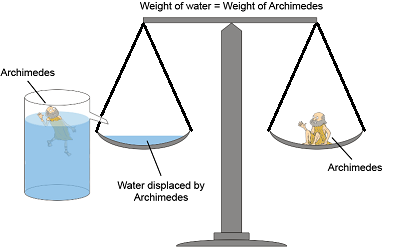Density:
- Mass of any fluid per unit volume is said to be density of that fluid.
- If M is the mass and V is the volume of an object, then
Density (d) = \(\frac{Mass}{Volume}\) = \(\frac{M}{V}\)
- The SI unit of density is Kg/m3
Density of different Material are:
|
Material |
Density(gram/cm3) |
|
Rubbing Alcohol |
0.79 |
|
Lamp Oil |
0.8 |
|
Baby Oil |
0.83 |
|
Water |
1.0 |
|
Milk |
1.03 |
|
Liquid Soap |
1.06 |
|
Corn Syrup |
1.33 |
|
Maple Syrup |
1.37 |
|
Honey |
1.42 |
Archimedes principle:
- According to Archimedes’ Principle, when a body is immersed partially or wholly in a fluid it experience a force which is equal to the weight of the displaced fluid.

Applications of Archimedes’ Principle:
- By the use of Archimedes’ principle we can determine the relative density of a substance.
- It has a great application in designing ships and submarines.
- Lactometer are designed to measure for milk purity.
- Hydrometer are designed to measure the density of water.
Relative density or Specific gravity:
- The ratio of density of any substance to that of density of water is said to be relative density.
Relative Density = \(\frac{Density\:of\:substance}{Density\:of\:water}\)
- Relative density has no unit as it is the ratio of similar quantities.
- The density of water at room temperature is 1g/cm3 this density is treated as a standard and density of any other material (usually liquids) is calculated relative to the density of water.
FAQ and Examples On Gravitation:
Q. What are the applications of Newton's Law of Gravitation?
Solution: There are several applications of Newton's law of gravitation. But one of the main application is to estimate masses of binary stars. A system of two stars orbiting round their common centre of mass is called binary star. Any irregularity in the motion of a star indicates that it might be another star or a planet going round the stars. This regularity in the motion of a star is called a wobble.
Q. Why is it difficult to hold a school bag having a strap made of a thin and strong string?
Solution: It is difficult to hold a bag having a strap made of a thin and strong string because the force of gravitation Bag exerts quiet large pressure on our shoulder. We already know that the pressure is inversly proportional to the surface area of the force action. If the surface area is smaller it will exert a greater force hence small contact surface of strip exerts a greater force.
Q. What is the magnitude of the gravitational force between the Earth and a 1 kg object on its surface? (Mass of the Earth is 6 × 1024 kg and radius of the Earth is 6.4 × 106 m).
Solution: As we know from the universal law of gravitation, gravitational force between two objects of masses M and m at a distance r from each other is given by:
F = G\(\frac{Mm}{r^{2}}\)
Here we are given with
G = 6.67 x 10-11Nm2/Kg2
M= 6 × 1024 kg
m= 1 Kg
r = 6.4 x 102
So, F = G\(\frac{6x10^{24} x 1}{{6.4 x 10^{2}}^{2}}\) = 9.8 N
Q. A ball is thrown vertically upwards with a velocity of 98 m/s. Calculate
(i) the maximum height to which it rises,
(ii) the total time it takes to return to the surface of the Earth.
Solution:
(i) For the upward motion of the ball, we use the equation:
v2 - u2 = 2 gh
where,
u = Initial velocity of the ball = 98 m/s (Given)
v = Final velocity of the ball = 0 (At the highest point)
h = Maximum height attained by the ball
g = Acceleration due to gravity = -9.8 m/s2 (Ball goes upwards opposite to the gravity)
Putting the values, we get
0 - (98)2 = 2 × (-9.8) × h
h = 490 m
(ii) Let t be the time taken by the ball to reach the height 490 m, then to find t we use the following equation of motion:
v = u + g t
Putting the values, we get
0 = 98 + (-9.8) × t
0 = 98 - 9.8 t
98 = 9.8 t
t= 10 s
But, Time of ascent = Time of descent
Therefore, the total time taken by the ball to return = 10 + 10 = 20 s